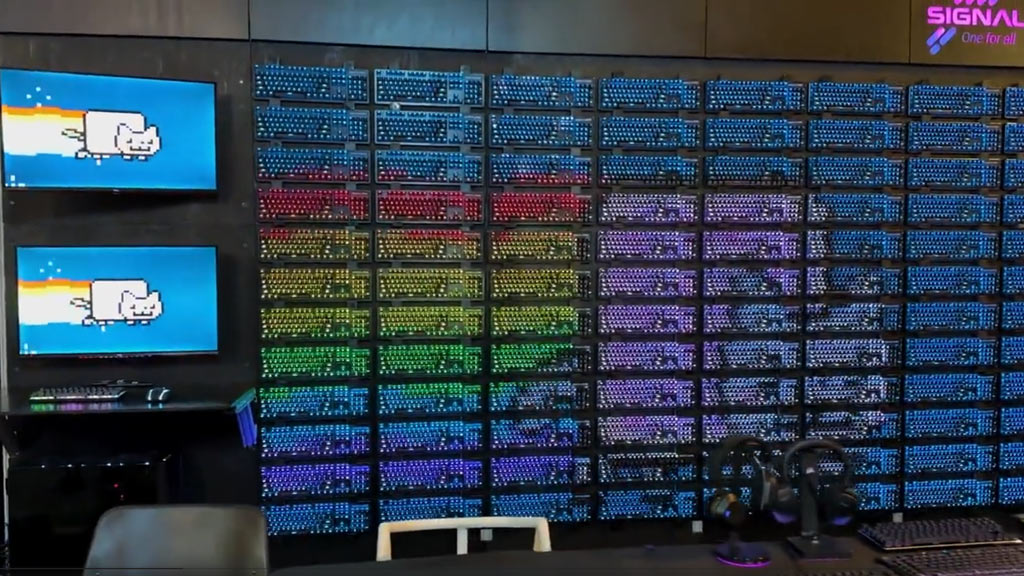00:00:00 In this section, Nick Espinoza discusses the issue of fake cell towers, also known as cell site simulators or stingrays, that can hijack iPhones and Android devices. These tools, used by both law enforcement and cybercriminals, create fake cellular towers to trick phones into connecting. While some carriers have disabled their 2G and 3G networks, many countries still rely on these networks, leading manufacturers to keep them enabled on their devices. Google has introduced measures to prevent connections to insecure towers, while Apple’s latest operating system, iOS 17, includes a lockdown mode to block 2G connections. Android users, specifically those on Google Pixel 6 or newer, also have the ability to disable 2G services.
00:05:00 In this section, the speaker discusses the susceptibility of Android devices to Stingray or Cell Site Simulator attacks and the lack of countermeasures by third-party manufacturers like Samsung. They mention the possibility of programming around this vulnerability in an open-source Android device and the hope that manufacturers will follow Apple’s lead in implementing lockdown mode. The speaker emphasizes the need for pressure on manufacturers to prioritize user safety and privacy by eliminating the risk of these attacks. They encourage viewers to engage on social media platforms and subscribe to their YouTube channel for more information on staying safe online.
Fake cell towers Are Hijacking Your iPhone/Android
SignalRGB Software Controls 96 Keyboard RGB Video Wall
SignalRGB hardware agnostic RGB control and sync software manages a huge wall of 96 keyboards, coaxing them to act as a single expansive display.
Source: SignalRGB Software Controls 96 Keyboard RGB Video Wall
Internet Censorship Doesn’t Make You Safe Online
In all actuality it can make you less safe.
Quantum Resitent FIDO2 Keys
Google is releasing new keys. I hope that these are much better than the Titan keys they had in the past. Those were a bust.
Fed Warning: US Space Industry Subject To Foreign Spying, Disruptions
The space industry must improve security as foreign intelligence entities seek to steal trade secrets and disrupt space-based infrastructure, US agencies caution.
Source: Fed Warning: US Space Industry Subject To Foreign Spying, Disruptions
Want to pwn a satellite? Turns out it’s surprisingly easy • The Register
PhD student admits he probably shouldn’t have given this talk
Source: Want to pwn a satellite? Turns out it’s surprisingly easy • The Register
Industrial Control Systems Vulnerabilities Soar: Over One-Third Unpatched in 2023
About 34% of security vulnerabilities impacting industrial control systems (ICSs) that were reported in the first half of 2023 have no patch or remediation, registering a significant increase from 13% the previous year. According to data compiled by SynSaber, a total of 670 ICS product flaws were reported via the U.S. Cybersecurity and Infrastructure Security Agency (CISA) in the first half of Attachments:
Source: Industrial Control Systems Vulnerabilities Soar: Over One-Third Unpatched in 2023
Researchers Find ‘Backdoor’ in Encrypted Police and Military Radios
A group of cybersecurity researchers has uncovered what they believe is an intentional backdoor in encrypted radios used by police, military, and critical infrastructure entities around the world. The backdoor may have existed for decades, potentially exposing a wealth of sensitive information transmitted across them, according to the researchers. While the researchers frame their discovery as a backdoor, the organization responsible for maintaining the standard pushes back against that specific term, and says the standard was designed for export controls which determine the strength of encryption. The end result, however, are radios with traffic that can be decrypted using consumer hardware like an ordinary laptop in under a minute. “There’s no other way in which this can function than that this is an intentional backdoor,” Jos Wetzels, one of the researchers from cybersecurity firm Midnight Blue, told Motherboard in a phone call. Do you know about other vulnerabilities in communications networks? We’d love to hear from you. Using a non-work phone or computer, you can contact Joseph Cox securely on Signal on +44 20 8133 5190, Wickr on josephcox, or email [email protected]. The research is the first public and in-depth analysis of the TErrestrial Trunked RAdio (TETRA) standard in the more than 20 years the standard has existed. Not all users of TETRA-powered radios use the specific encryption algorithim called TEA1 which is impacted by the backdoor. TEA1 is part of the TETRA standard approved for export to other countries. But the researchers also found other, multiple vulnerabilities across TETRA that could allow historical decryption of communications and deanonymization. TETRA-radio users in general include national police forces and emergency services in Europe; military organizations in Africa; and train operators in North America and critical infrastructure providers elsewhere. Midnight Blue will be presenting their findings at the upcoming Black Hat cybersecurity conference in August. The details of the talk have been closely under wraps, with the Black Hat website simply describing the briefing as a “Redacted Telecom Talk.” That reason for secrecy was in large part due to the unusually long disclosure process. Wetzels told Motherboard the team has been disclosing these vulnerabilities to impacted parties so they can be fixed for more than a year and a half. That included an initial meeting with Dutch police in January 2022, a meeting with the intelligence community later that month, and then the main bulk of providing information and mitigations being distributed to stakeholders. NLnet Foundation, an organization which funds “those with ideas to fix the internet,” financed the research. The European Telecommunications Standards Institute (ETSI), an organization that standardizes technologies across the industry, first created TETRA in 1995. Since then, TETRA has been used in products, including radios, sold by Motorola, Airbus, and more. Crucially, TETRA is not open-source. Instead, it relies on what the researchers describe in their presentation slides as “secret, proprietary cryptography,” meaning it is typically difficult for outside experts to verify how secure the standard really is. The researchers said they worked around this limitation by purchasing a TETRA-powered radio from eBay. In order to then access the cryptographic component of the radio itself, Wetzels said the team found a vulnerability in an interface of the radio. From there, they achieved code execution on the main application processor; they then jumped to the signals processor, which Wetzels described as something equivalent to a wifi or 3G chip, which handles the radio’s signals. On that chip, a secure enclave held the cryptographic ciphers themselves. The team finally found vulnerabilities in that which allowed them to extract the cryptography and perform their analysis. The team then reverse-engineered how TETRA implemented its cryp
Source: Researchers Find ‘Backdoor’ in Encrypted Police and Military Radios
Commentary on the Implementation Plan for the 2023 US National Cybersecurity Strategy
The Atlantic Council released a detailed commentary on the White House’s new “Implementation Plan for the 2023 US National Cybersecurity Strategy.” Lots of interesting bits. So far, at least three trends emerge: First, the plan contains a (somewhat) more concrete list of actions than its parent strategy, with useful delineation of lead and supporting agencies, as well as timelines aplenty. By assigning each action a designated lead and timeline, and by including a new nominal section (6) focused entirely on assessing effectiveness and continued iteration, the ONCD suggests that this is not so much a standalone text as the framework for an annual, crucially iterative policy process. That many of the milestones are still hazy might be less important than the commitment. the administration has made to revisit this plan annually, allowing the ONCD team to leverage their unique combination of topical depth and budgetary review authority. Second, there are clear wins. Open-source software (OSS) and support for energy-sector cybersecurity receive considerable focus, and there is a greater budgetary push on both technology modernization and cybersecurity research. But there are missed opportunities as well. Many of the strategy’s most difficult and revolutionary goals—holding data stewards accountable through privacy legislation, finally implementing a working digital identity solution, patching gaps in regulatory frameworks for cloud risk, and implementing a regime for software cybersecurity liability—have been pared down or omitted entirely. There is an unnerving absence of “incentive-shifting-focused” actions, one of the most significant overarching objectives from the initial strategy. This backpedaling may be the result of a new appreciation for a deadlocked Congress and the precarious present for the administrative state, but it falls short of the original strategy’s vision and risks making no progress against its most ambitious goals. Third, many of the implementation plan’s goals have timelines stretching into 2025. The disruption of a transition, be it to a second term for the current administration or the first term of another, will be difficult to manage under the best of circumstances. This leaves still more of the boldest ideas in this plan in jeopardy and raises questions about how best to prioritize, or accelerate, among those listed here.
Source: Commentary on the Implementation Plan for the 2023 US National Cybersecurity Strategy
-
Recent Posts
-
Archives
- April 2024
- March 2024
- February 2024
- January 2024
- December 2023
- November 2023
- October 2023
- September 2023
- August 2023
- July 2023
- June 2023
- May 2023
- April 2023
- March 2023
- February 2023
- January 2023
- December 2022
- November 2022
- October 2022
- September 2022
- August 2022
- July 2022
- June 2022
- May 2022
- April 2022
- March 2022
- February 2022
- January 2022
- December 2021
- November 2021
-
Meta

